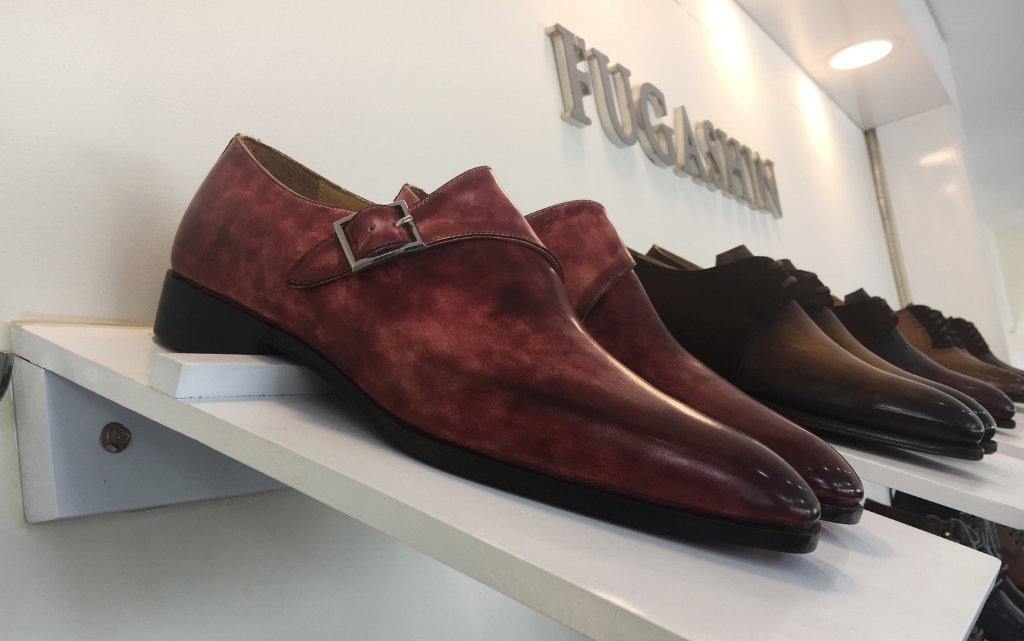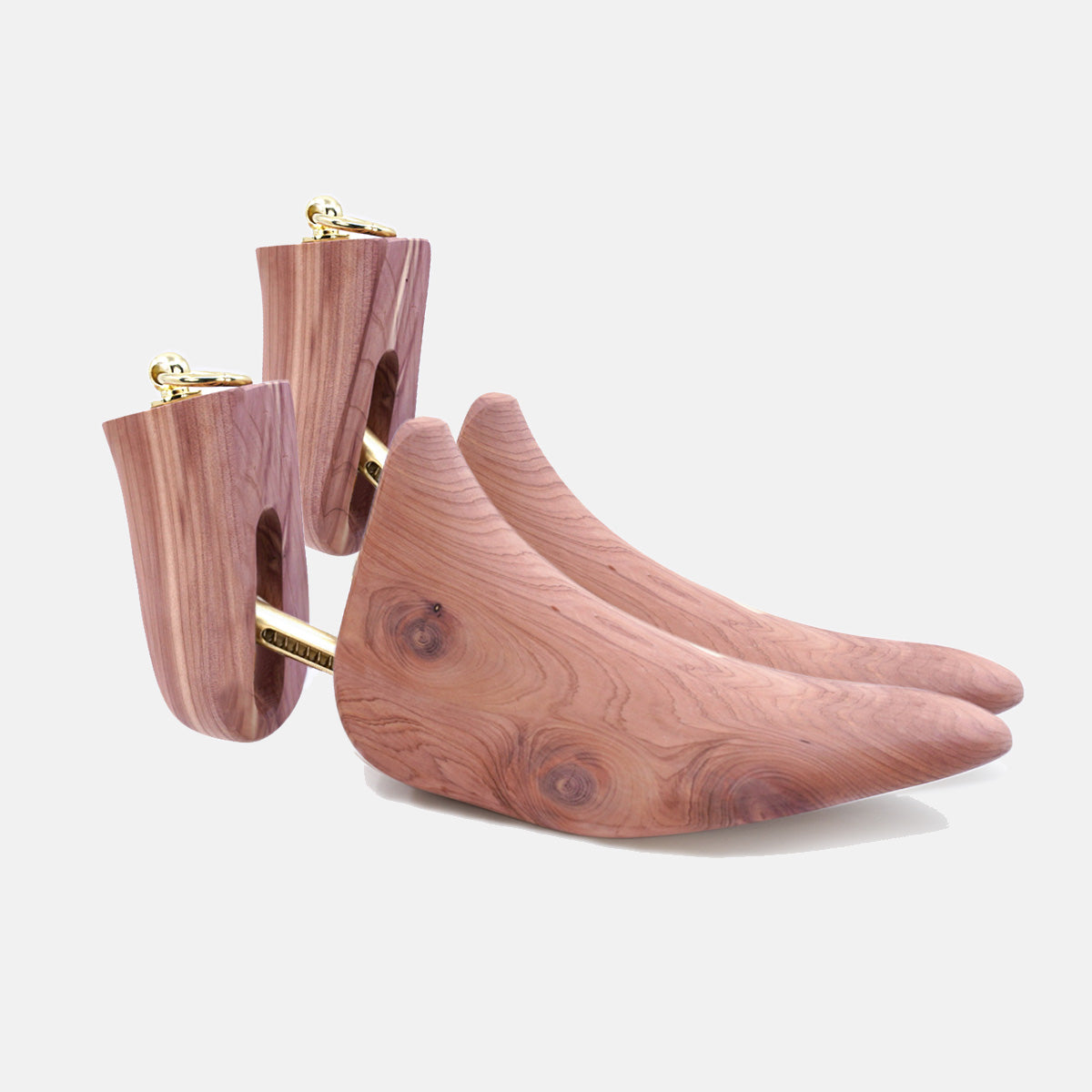Get 10% Off - Auto Applied At Checkout
Get 10% Off - Auto Applied At Checkout
Shoe Trees
shoe stretchers
Sets

Fugashin Saigon Impressions & Factory Tour
October 04, 2018 6 min read
Our hotel was located next to the Japanese department store Takashimaya. Not the first department store one expects to see in Ho Chi Min City, Vietnam.
But this was District One, a place of bright lights, culinary delights and trendy shopping precincts. In bygone years, it was the world of the privileged expat, the epitome of colonial chic, introduced to many by Graeme Green’s novel, A Quiet American.
Strident steps have been taken since the interluding war years. Today, Takashimaya represents in many ways the modernisation and internationalisation of this bustling city.
One shoe brand, in particular, displayed proudly within the shoe department of Takashimaya, has made its mark in both Vietnam and Japan.
Fugashin is a relative newcomer to the world of luxury footwear, but they are certainly making up for lost time, and in the process, facilitating a country's 'strident steps' towards prosperity, with a touch of class.
Fugashin Saigon
We arrived at the Fugashin Saigon factory, one of two factories in the South of Vietnam, located in an outer suburb of Ho Chi Min City.
The street facing entrance was a simple but attractive shop front with rows of shoes on display. I am greeted by brogues, loafers, oxfords, boots; hand sewn, Goodyear welt, Black stitch, storm welt construction; burnished leather, velvety nap, supple leather from Italy and France. It's pure shoe candy and the gorgeous Fiddleback waists of many of the shoes do not go unnoticed.
 Shoe Candy at Fugashin Saigon Ho Chi Min City Factory Shopfront
Shoe Candy at Fugashin Saigon Ho Chi Min City Factory Shopfront
Lost in thought, I almost miss the entrance of Fugashin Saigon director, Nguyen. Nguyen has a disarming smile and equally 'disarming' grip. This is a man who has hand sewn a shoe or two in his lifetime.
We are taken upstairs to an office that overlooks production below. I am introduced to the CEO of Fugashin Saigon and Thanh, another director and boss of this particular factory, who helped organise this meeting.
Thanh explains that Fugashin is a joint venture between Japanese company Vinaseiko Co. Ltd. and Vietnamese company Thuan Phong Co. Ltd.. I am informed that the relationship between these two companies runs deeper than mere business, and at the heart of it, Fugashin is a family run business.
The Japanese connection
The origins of Fugashin has its roots in the rise of the Japanese shoemaker.
In the early 2000s, Japanese interest in luxury footwear was piqued. Names like Yohei Fukuda and Yuki Shiraham travelled to Europe to learn from the Masters and bring their newly acquired craft back to home soil.
 Yohei Fukuda brought his craft back to Japan and is now one of the pre-eminent bespoke shoemakers in Japan. Photos @Permanent Style
Yohei Fukuda brought his craft back to Japan and is now one of the pre-eminent bespoke shoemakers in Japan. Photos @Permanent Style
Today Japan boasts some of the most sought after bespoke shoemakers in the World. Demand is so high, infact, that wait times can be very long, up to 18 months not being uncommon.
Such demand for quality men's footwear in Japan gave rise to Fugashin. Still relatively young, about a decade old, their ready-to-wear shoes are sold in major Japanese and Vietnamese department stores, ranging in price from $300 USD to $1,000 USD. They also produce shoes for major labels from around the world.
The Fugashin joint venture has given Fugashin Saigon access to Japanese technical expertise and training, which is needed if they are to meet the high demands of Japan's luxury shoe market; but also the local market, which places quality in increasingly higher regard.
Approach to quality
Quality and reliability are two inarguable attributes required of Japanese products. The demands put on manufacturers by Japanese buyers are, without any evidence, the probable cause for facial tics amongst factory owners.
But Fugashin seems to embrace the high demands of Japanese consumers. When Nguyen and Thanh explain their manufacturing and quality control processes, their description reads straight out of a 'Total Quality Control' (TQC) playbook.
 Fugashin must employ very high standards to satisfy the high demands of the Japanese luxury shoe market. Photo @Fugashin
Fugashin must employ very high standards to satisfy the high demands of the Japanese luxury shoe market. Photo @Fugashin
Thanh explains that for each shoe there are approximately 200 steps. One misstep and the product is fixed or binned.
Their focus is on producing a quality product that the customer will love, not short-term profits. They are also keenly aware of some of the quality control issues faced by shoe brands that partner with regional shoemakers in their quest for scale (which I've had the misfortune of experiencing at the consumer-end).
There are demands from local customers too. Vietnam's economy is currently undergoing a boom of sorts, and with rising incomes and living standards, Vietnamese consumers are placing greater emphasis on the quality of the products that they purchase.
Vietnam's recent 'tail of two metros' fuels local assumptions about the superiority of Japanese workmanship and engineering. In Hanoi, the Chinese state-sponsored contractor has experienced project delays, budget blowouts, and accidents. In stark contrast, Ho Chi Min City's Japanese-led metro rail project is on schedule, on budget and accident-free. This feeds well into Fugashin's approach to quality and expansion into the local market.
The Factory Tour
Nguyen shows us around the factory. It is a large warehouse with good natural light and circulation (which is surprising considering the humidity outside).
The different workstations are sectioned in a sequential order. One can walk the perimeter of the factory and see the shoe from almost start to finish.
Our tour begins in the leather room below the office. Rolls of raw calf hide and suede from France and Italy are laid out on a table. One tannery in particular - which I cannot name - has an old and well-deserved reputation.
 Fugashin leather is sourced from Tanneries in France and Italy
Fugashin leather is sourced from Tanneries in France and Italy
Next stop is the clicking section. Staff meticulously examine the hides to select the best parts to use. Groups of (female) workers carefully cut out the different parts of the shoe's upper. They hardly notice me as they concentrate intently at the task at hand.
Unfortunately, I didn't get to see any stitching or punching at that time. The uppers are then simply placed on an open rack, as the closing section resides on the other side.
 Clicking, Punching and Sewing before awaiting Lasting
Clicking, Punching and Sewing before awaiting Lasting
We then move onto the Lasting section. It is manned by several workers. Their lasting machines draw the uppers tightly around the lasts. The upper is then further drawn tightly and smoothly by hand and tool.
We progress through the production process, as the shoe is trimmed, welted, soled, heeled, (burnished) and finished. I stare with admiration as the finishers polish up a batch of whole cut dress shoes. They do seem to like their burnished leather in Vietnam. Burnishing is a skill I've dabbled in but it takes a person with far more time, patience and shoes than I.
 Pairs of whole cut dress shoes find their way to the Finishing section
Pairs of whole cut dress shoes find their way to the Finishing section
The whole tour concludes pretty much where it kicked off. It's been an eye-opening visit and I'm very impressed by the efficiency and skill of the Fugashin workforce. Clearly, they are valued and take pride in their work.
Tour Conclusion & Store Visit
We thank Nguyen and Thanh for their time and re-enter their storefront. Nguyen leads us to some of the finished shoes and shows me a pair of boots that he enjoys making - confirming my initial impression.
Impressed as I am, I express interest in purchasing a pair (similar to the one he showed me). There isn't many options in size 45, so I'm given directions to their District Three store, which is near our accommodation.
 Some fine looking shoes for sale at their District 3 store.
Some fine looking shoes for sale at their District 3 store.
The Fugashin District 3 store is directly in front of the War Remnants Museum (which is visited by 99.9% of all Ho Chi Min City visitors). It also has a coffee bar (Fugashin Coffee) and serves some very decent brew.
The store is attractive and the attendants are friendly and attentive. I selected a Service Boot in Tan with Norwegian construction, which they make specifically for my size.
Final Thoughts
Fugashin operate in a highly competitive market. Through delivering a quality product, they have made envious headway in both Japanese and Vietnamese luxury shoe markets.
Fugashin Saigon impressed me with their range, quality, and workmanship.
Their pricing is quite competitive, especially at the 300-600 USD range. In this price range, you will be hard pressed to find a better quality produced in the region, including European shoemakers who outsource production in Asia.
I look forward to trying out my new Fugashin boots. Until I have worn them in, I will leave it to those more qualified than me to verify the quality of Fugashin shoes. Suffice to say, from my own observation, it is evident that, at the very least, Fugashin take great pride in producing a shoe their customers love.
Fugashin fits so well into the District One landscape, as I am sure it would in Tokyo. I also believe it is a shoe brand to watch out for and would do very well in greenfield markets, such as Australia and New Zealand.
A big thank you to Nguyen and Thanh.
Subscribe
Sign up to get the latest on sales, new releases and more …











